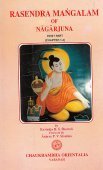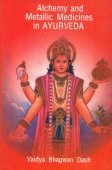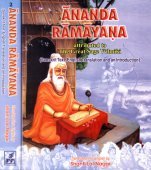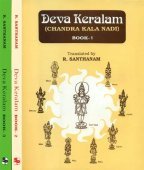Deha: 27 definitions
Introduction:
Deha means something in Hinduism, Sanskrit, Jainism, Prakrit, Buddhism, Pali, Marathi, Hindi. If you want to know the exact meaning, history, etymology or English translation of this term then check out the descriptions on this page. Add your comment or reference to a book if you want to contribute to this summary article.
Alternative spellings of this word include Deh.
In Hinduism
Ayurveda (science of life)
Source: Wisdom Library: Āyurveda and botanyDeha (देह) refers to “the anabolic character of the lving body”. The term is used throughout Ayurvedic literature such as the Suśruta-saṃhitā and the Caraka-saṃhitā.
Source: gurumukhi.ru: Ayurveda glossary of terms1) Deha (देह):—The living body. Indicative of growth in the bodily tissues.
2) [dehaḥ] Body

Āyurveda (आयुर्वेद, ayurveda) is a branch of Indian science dealing with medicine, herbalism, taxology, anatomy, surgery, alchemy and related topics. Traditional practice of Āyurveda in ancient India dates back to at least the first millenium BC. Literature is commonly written in Sanskrit using various poetic metres.
Purana and Itihasa (epic history)
Source: archive.org: Shiva Purana - English TranslationDeha (देह) refers to the “body”, according to the Śivapurāṇa 2.1.12, while explaining details of worship:—“[...] as long as there is a vestige of sin in the body (deha), achievement need not be expected. When the sin is wiped off, all rites will bear fruit. If there is dirt in the cloth the dyeing process cannot be carried out effectively. After the cloth is bleached any dye can be applied to it effectively. Similarly when the body (deha) is freed of its dirty stuff by proper worship of deities, the dye of knowledge can stick to it whence true knowledge will arise”.
Source: Cologne Digital Sanskrit Dictionaries: The Purana Index1a) Deha (देह).—Human body; as a temple; philosophical interpretation of.*
- * Brahmāṇḍa-purāṇa IV. 43. 53-54 ff.
1b) One of the twenty Amitābha gaṇas.*
- * Vāyu-purāṇa 100. 17.

The Purana (पुराण, purāṇas) refers to Sanskrit literature preserving ancient India’s vast cultural history, including historical legends, religious ceremonies, various arts and sciences. The eighteen mahapuranas total over 400,000 shlokas (metrical couplets) and date to at least several centuries BCE.
Shilpashastra (iconography)
Source: archive.org: Illustrations of Indian Music and Dance in Western Indian StyleDeha (देह) refers to one of the forty-seven tānas (tone) used in Indian music.—The illustration of Deha (as a deity) according to 15th-century Indian art is as follows.—The colour of bis body is yellow. His face is similar to the face of a horse. A viṇā is in his both bands.
The illustrations (of, for example Deha) are found scattered throughout ancient Jain manuscripts from Gujarat. The descriptions of these illustrations of this citrāvalī are based on the ślokas of Vācanācārya Gaṇi Sudhākalaśa’s Saṅgītopaniṣatsāroddhāra (14th century) and Śārṅgadeva’s Saṅgītaratnākara (13th century).

Shilpashastra (शिल्पशास्त्र, śilpaśāstra) represents the ancient Indian science (shastra) of creative arts (shilpa) such as sculpture, iconography and painting. Closely related to Vastushastra (architecture), they often share the same literature.
Vaishnavism (Vaishava dharma)
Source: Pure Bhakti: Brhad BhagavatamrtamDeha (देह) refers to:—The physical body. (cf. Glossary page from Śrī Bṛhad-bhāgavatāmṛta).

Vaishnava (वैष्णव, vaiṣṇava) or vaishnavism (vaiṣṇavism) represents a tradition of Hinduism worshipping Vishnu as the supreme Lord. Similar to the Shaktism and Shaivism traditions, Vaishnavism also developed as an individual movement, famous for its exposition of the dashavatara (‘ten avatars of Vishnu’).
Vastushastra (architecture)
Source: Brill: Śaivism and the Tantric Traditions (architecture)Deha (देह) refers to an “(architectural) site”, according to the Devyāmata (in the section śalyoddhāra-paṭala or “excavation of extraneous substances”).—Accordingly, “Next, I shall, as told before, teach the characteristics of extraneous substances, which exist beneath the site and cause calamities to people. When the site, which has been made square, is being divided with cords, [the officiant] who has knowledge of divisions of the site (vāstu-deha-vibhāgajña) should investigate extraneous substances by omens, etc. [...]”.

Vastushastra (वास्तुशास्त्र, vāstuśāstra) refers to the ancient Indian science (shastra) of architecture (vastu), dealing with topics such architecture, sculpture, town-building, fort building and various other constructions. Vastu also deals with the philosophy of the architectural relation with the cosmic universe.
In Jainism
General definition (in Jainism)
Source: Wisdom Library: JainismDeha (देह) refers to a class of piśāca deities according to both the Digambara and Śvetāmbara traditions of Jainism. The piśācas refer to a category of vyantaras gods which represents one of the four classes of celestial beings (devas).
The deities such as Dehas are defined in ancient Jain cosmological texts such as the Saṃgrahaṇīratna in the Śvetāmbara tradition or the Tiloyapaṇṇati by Yativṛṣabha (5th century) in the Digambara tradition.
Source: archive.org: Een Kritische Studie Van Svayambhūdeva’s PaümacariuDeha (देह) participated in the war between Rāma and Rāvaṇa, on the side of the latter, as mentioned in Svayambhūdeva’s Paumacariu (Padmacarita, Paumacariya or Rāmāyaṇapurāṇa) chapter 57ff. Svayambhū or Svayambhūdeva (8th or 9th century) was a Jain householder who probably lived in Karnataka. His work recounts the popular Rāma story as known from the older work Rāmāyaṇa (written by Vālmīki). Various chapters [mentioning Deha] are dedicated to the humongous battle whose armies (known as akṣauhiṇīs) consisted of millions of soldiers, horses and elephants, etc.
Source: The University of Sydney: A study of the Twelve Reflections1) Deha (देह) refers to the “body”, according to the 11th century Jñānārṇava, a treatise on Jain Yoga in roughly 2200 Sanskrit verses composed by Śubhacandra.—Accordingly, “Or, the Supreme Soul is not perceived through its own nature which is unknown. The individual self is to be ascertained first in order to discern the Supreme Soul. Further, there may not be an abiding in the self for one who is ignorant of the real state of the self. Hence he fails to distinguish between the nature of the body and the self (deha-dehin—kartuṃ svarūpaṃ dehadehinoḥ)”.
Synonyms: Śarīra, Vapus, Kalevara.
2) Deha (देह) (Cf. Vapus) refers to the “body”, according to the Yaśastilaka Campū verse 2.123-214.—Accordingly, “Never imagine that thou art composed of the body (deha-ātmaka), because the body (vapus) is utterly different from thee. Thou art all consciousness, an abode of virtue and bliss; whereas the body, because it is inert, is an unconscious mass. The body exists and grows so long as thou art in existence. When thou art dead, it disappears in the form of earth, air and the like. Composed of the elements it is devoid of feelings such as joy, like a corpse. Hence the blissful self is surely different from the body.

Jainism is an Indian religion of Dharma whose doctrine revolves around harmlessness (ahimsa) towards every living being. The two major branches (Digambara and Svetambara) of Jainism stimulate self-control (or, shramana, ‘self-reliance’) and spiritual development through a path of peace for the soul to progess to the ultimate goal.
Languages of India and abroad
Pali-English dictionary
Source: BuddhaSasana: Concise Pali-English Dictionarydeha : (m. nt.) the body.
Source: Sutta: The Pali Text Society's Pali-English DictionaryDeha, (Sk. deha to *dheigh to form, knead, heap up (cp. kāya=heap), see diddha. So also in uddehaka. Cp. Kern, Toev. p. 75 s. v. sarīradeha. Cp. Gr. teίxos (wall)=Sk. dehī; Lat. fingo & figura; Goth. deigan (knead)=Ohg. teig=E. dough) body A.II, 18; PvA.10, 122. Usually in foll. phrases: hitvā mānusaṃ dehaṃ S.I, 60; Pv.II, 956; pahāya m. d. S.I, 27, 30; jahati d. M.II, 73; °ṃ nikkhipati Pv.II, 615; (muni or khīṇāsavo) antima-deha-dhārin (°dhāro) S.I, 14, 53; II, 278; Sn.471; Th.II, 7, 10; It.32, 40, 50, 53. °nikkhepana laying down the body Vism.236. (Page 331)

Pali is the language of the Tipiṭaka, which is the sacred canon of Theravāda Buddhism and contains much of the Buddha’s speech. Closeley related to Sanskrit, both languages are used interchangeably between religions.
Marathi-English dictionary
Source: DDSA: The Molesworth Marathi and English Dictionarydēha (देह).—m (S) The body. dēha ugāḷaṇēṃ To wear down one's body (as in service &c.) dēha kāraṇīṃ lāvaṇēṃ g. of o. To spend one's self in the cause of. dēha ṭākaṇēṃ-ṭhēvaṇēṃ-mōḍaṇēṃ To cast off the tabernacle of clay. dēhaṃ vā pātayēt arthaṃ vā sādhayēt Lose one's life or gain one's object. dēhānta ujēḍa paḍaṇēṃ To get light (respecting one's crime or sin) by suffering its penalty. dēhānta asūna vidēhī One, although in the body, living as freed from it; one of subdued affections and desires. dēhāvara asaṇēṃ To be in one's senses or right mind. dēhāvara gāṇēṃ-gīta-abhaṅga-pada-lāvaṇī kavana &c. Used of a kind of Double entendre consisting of allusions to the privities and pudenda of the human body, but bearing spiritual or mystic signification. dēhāvara asaṇēṃ To be wandering or absent in mind. dēhāvara yēṇēṃ To come to one's senses, lit. fig.; to leave off wild tricks or loose practices. dēhīṃ dēvapaṇa dākhaviṇēṃ-āṇaṇēṃ-yēṇēṃ &c. To evince &c. knowledge of Divine or spiritual truth whilst in the body.
--- OR ---
dēha (देह).—m ( P) A village. And dēhahāya, dēhē- hāya, dēhāya m pl ( P) Villages. In notes and official papers.
Source: DDSA: The Aryabhusan school dictionary, Marathi-Englishdēha (देह).—m The body. dēha kāraṇīṃ lāvaṇēṃ Spend one's self in the cause of. dēhāvara asaṇēṃ Be in one's senses or right mind. dēhāvara nasaṇēṃ Be absent in mind; be wild. dēhāvara yēṇēṃ Come to one's senses; leave off mad pranks.
Marathi is an Indo-European language having over 70 million native speakers people in (predominantly) Maharashtra India. Marathi, like many other Indo-Aryan languages, evolved from early forms of Prakrit, which itself is a subset of Sanskrit, one of the most ancient languages of the world.
Sanskrit dictionary
Source: DDSA: The practical Sanskrit-English dictionaryDeha (देह).—[dih-ghañ]
1) The body; देहं दहन्ति दहना इव गन्धवाहाः (dehaṃ dahanti dahanā iva gandhavāhāḥ) Bv.1.14.
2) A form, shape, bulk, mass,
3) A person, an individual.
4) An appearance, a manifestation. -हः (haḥ) Anointing, smearing.
-hī A rampart, wall, mound.
Derivable forms: dehaḥ (देहः), deham (देहम्).
Source: Cologne Digital Sanskrit Dictionaries: Shabda-Sagara Sanskrit-English DictionaryDeha (देह).—mn.
(-haḥ-haṃ) The body. E. diha to collect together, affix ghañ .
Source: Cologne Digital Sanskrit Dictionaries: Benfey Sanskrit-English DictionaryDeha (देह).—i. e. dih + a, m. and n. The body, [Mānavadharmaśāstra] 6, 40.
Source: Cologne Digital Sanskrit Dictionaries: Cappeller Sanskrit-English DictionaryDeha (देह).—[masculine] [neuter] body, person, [abstract] tva [neuter]; [feminine] dehī mound, wall.
Source: Cologne Digital Sanskrit Dictionaries: Aufrecht Catalogus CatalogorumDeha (देह) as mentioned in Aufrecht’s Catalogus Catalogorum:—(?) by Rāmānuja. Rice. 148.
Source: Cologne Digital Sanskrit Dictionaries: Monier-Williams Sanskrit-English Dictionary1) Deha (देह):—mn. (√dih, to plaster, mould, fashion) the body, [Taittirīya-āraṇyaka; Kātyāyana-śrauta-sūtra; Manu-smṛti] etc.
2) (in a triad with manas and vāc), [Manu-smṛti i, 104 etc.]
3) (haṃdhāraya, to support the body id est. exist, [Nalopākhyāna])
4) form, shape, mass, bulk (as of a cloud; ifc. f(ā). ), [Varāha-mihira]
5) person, individual, [Subhāṣitāvali]
6) appearance, manifestation ifc. having the appearance of (saṃdeha-, [Bālarāmāyaṇa iii, 43/44])
7) Name of a country, [cf. Lexicographers, esp. such as amarasiṃha, halāyudha, hemacandra, etc.]
Source: Cologne Digital Sanskrit Dictionaries: Yates Sanskrit-English DictionaryDeha (देह):—[(haḥ-haṃ)] 1. m. n. The body.
Source: DDSA: Paia-sadda-mahannavo; a comprehensive Prakrit Hindi dictionary (S)Deha (देह) in the Sanskrit language is related to the Prakrit word: Deha.
[Sanskrit to German]
Sanskrit, also spelled संस्कृतम् (saṃskṛtam), is an ancient language of India commonly seen as the grandmother of the Indo-European language family (even English!). Closely allied with Prakrit and Pali, Sanskrit is more exhaustive in both grammar and terms and has the most extensive collection of literature in the world, greatly surpassing its sister-languages Greek and Latin.
Hindi dictionary
Source: DDSA: A practical Hindi-English dictionaryDeha (देह) [Also spelled deh]:—(nf) body, person; physique; soma; ~[tyāga] voluntary end of life, abandonment of the physical form; -[dharma] physical/bodily functions; corporeal requirements; ~[dharmī] somatic; ~[dhārī] possessing a physical form/body; corporeal; ~[pāta] death; ~[vijñāna] somatology; ~[sāra] somaplasm; —[ko laganā] to nourish the body; —[curānā] (said of a woman) to conceal one’s youthfulness/physical charm; —[choḍanā] to die; —[ṭūṭanā] to feel pain in the body (due to strain, exhaustion, exertion or fever); —[ḍhalanā] physical decay/decline to set in; to become loose and lustreless; to lose muscularity; —[dharanā] to be born; to acquire a physical form; —[dhare ko daṃḍa hai saba kāhū ko hoya] its the way of all flesh; —[meṃ āga laganā] to get infuriated/enraged.
...
Prakrit-English dictionary
Source: DDSA: Paia-sadda-mahannavo; a comprehensive Prakrit Hindi dictionaryDeha (देह) in the Prakrit language is related to the Sanskrit word: Deha.
Prakrit is an ancient language closely associated with both Pali and Sanskrit. Jain literature is often composed in this language or sub-dialects, such as the Agamas and their commentaries which are written in Ardhamagadhi and Maharashtri Prakrit. The earliest extant texts can be dated to as early as the 4th century BCE although core portions might be older.
Kannada-English dictionary
Source: Alar: Kannada-English corpusDēha (ದೇಹ):—[noun] the physical structure and material substance of an animal, living or dead; the body.
Kannada is a Dravidian language (as opposed to the Indo-European language family) mainly spoken in the southwestern region of India.
See also (Relevant definitions)
Starts with (+179): Dehabaddha, Dehabalika, Dehabandha, Dehabhaj, Dehabhana, Dehabhanagollu, Dehabhava, Dehabheda, Dehabhilashe, Dehabhimana, Dehabhimani, Dehabhrit, Dehabhuj, Dehabidu, Dehabuddhi, Dehacara, Dehacarya, Dehacatushtayavyavasthalakshana, Dehachyuta, Dehacyuta.
Ends with (+127): Abhisamdeha, Abhisandeha, Adeha, Adhishthanadeha, Alpadeha, Annasamdeha, Antarabhavadeha, Antardeha, Anupadeha, Aparavideha, Arthasamdeha, Asamdeha, Ashtadeha, Asthiradeha, Asyopadeha, Atmasamdeha, Atmasandeha, Aurdhvadeha, Avaruddhadeha, Avataritadeha.
Full-text (+366): Dehavarana, Krishnadeha, Dehatyaga, Dehasara, Dehakshaya, Purvadeha, Dehambhara, Dehadharana, Dehayatra, Urdhvadeha, Dehin, Dehabhuj, Dehadhrik, Dehadharaka, Bhinnadeha, Dvideha, Pratideham, Dehabhrit, Dehatva, Dehasvabhava.
Relevant text
Search found 88 books and stories containing Deha, Dēha; (plurals include: Dehas, Dēhas). You can also click to the full overview containing English textual excerpts. Below are direct links for the most relevant articles:
Garga Samhita (English) (by Danavir Goswami)
Verse 1.14.23 < [Chapter 14 - The Liberation of Śakaṭāsura and Tṛṇāvarta]
Verse 2.16.15 < [Chapter 16 - The Worship of Tulasī]
Verse 1.14.21 < [Chapter 14 - The Liberation of Śakaṭāsura and Tṛṇāvarta]
Sahitya-kaumudi by Baladeva Vidyabhushana (by Gaurapada Dāsa)
Text 9.32 < [Chapter 9 - Ornaments of Sound]
Text 4.13 < [Chapter 4 - First-rate Poetry]
Text 8.11 < [Chapter 8 - Literary Qualities]
Brihad Bhagavatamrita (commentary) (by Śrī Śrīmad Bhaktivedānta Nārāyana Gosvāmī Mahārāja)
Verse 2.3.9 < [Chapter 3 - Bhajana (loving service)]
Verse 2.1.40 < [Chapter 1 - Vairāgya (renunciation)]
Verse 1.7.95 < [Chapter 7 - Pūrṇa (pinnacle of excellent devotees)]
Shrimad Bhagavad-gita (by Narayana Gosvami)
Verses 8.12-13 < [Chapter 8 - Tāraka-brahma-yoga (the Yoga of Absolute Deliverance)]
Verse 4.9 < [Chapter 4 - Jñāna-Yoga (Yoga through Transcendental Knowledge)]
Verse 15.14 < [Chapter 15 - Puruṣottama-toga (Yoga through understanding the Supreme Person)]
Mundaka Upanishad (Madhva commentary) (by Srisa Chandra Vasu)
Chapter 6 - Third Mundaka, Second Khanda
Chapter 4 - Second Mundaka, Second Khanda
Chaitanya Bhagavata (by Bhumipati Dāsa)
Verse 3.9.113 < [Chapter 9 - The Glories of Advaita]
Verse 3.2.495 < [Chapter 2 - Description of the Lord’s Travel Through Bhuvaneśvara and Other Placesto Jagannātha Purī]
Verse 2.4.70 < [Chapter 4 - Revelation of Nityānanda’s Glories]
Related products




